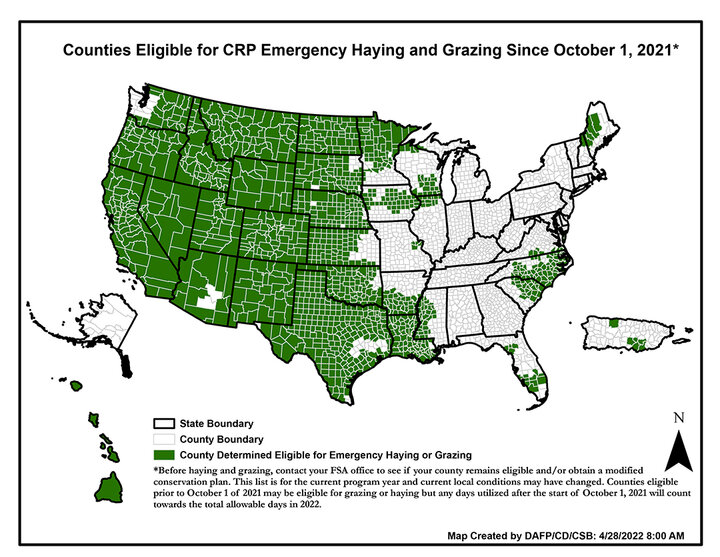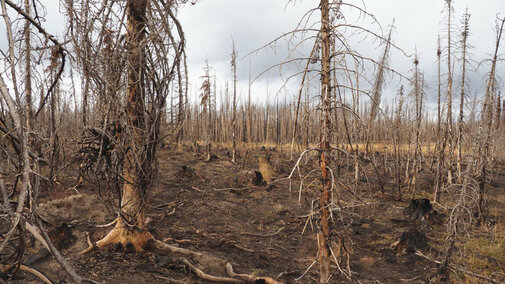The U.S. Department of Agriculture (USDA) has technical and financial assistance available to help Nebraska farmers and livestock producers across the state recover from recent wildfires and ongoing drought. Producers impacted by these events should contact their local USDA Service Center to report losses and learn more about program options available to assist in their recovery from crop, land, infrastructure and livestock losses and damages.
USDA Disaster Assistance for Drought and Wildfire Recovery
Producers who experience livestock deaths in excess of normal mortality due to wildfires may be eligible for the Livestock Indemnity Program (LIP). To participate in LIP, producers will be required to provide verifiable documentation of death losses resulting from an eligible adverse weather event and must submit a notice of loss to their local FSA office within 30 calendar days of when the loss of livestock is apparent.
The Emergency Assistance for Livestock, Honeybees, and Farm-Raised Fish Program (ELAP) provides eligible producers with compensation for losses due to disease, certain adverse weather events or loss conditions as determined by the Secretary of Agriculture. For drought-impacted areas, ELAP also covers above normal costs to transport feed and water to livestock or haul livestock to forage or other grazing acres. For ELAP, producers will need to file a notice of loss within 30 days and honeybee losses within 15 days.

Livestock producers may also be eligible for the Livestock Forage Disaster Program (LFP) for 2022 grazing losses due to drought when grazing land or pastureland is physically located in a county rated by the U.S. Drought Monitor as having a D2 intensity for eight consecutive weeks, D3 drought intensity or greater. FSA maintains a list of counties eligible for LFP and makes updates each Thursday.
Additionally, eligible orchardists and nursery tree growers may be eligible for cost-share assistance through the Tree Assistance Program (TAP) to replant or rehabilitate eligible trees, bushes or vines lost during the wildfires or drought. This complements Noninsured Crop Disaster Assistance Program (NAP) or crop insurance coverage, which covers the crop but not the plants or trees in all cases. For TAP, a program application must be filed within 90 days.
“When you are at a time and place where you can safely assess the wildfire impact or ongoing drought on your operation, be sure to contact your local FSA office to timely report all crop, livestock and farm infrastructure damages and losses,” said John Berge, State Executive Director for the Farm Service Agency (FSA) in Nebraska. “To accelerate the FSA disaster assistance process, please be prepared to provide important documents, such as farm records, herd inventory, receipts and pictures of damages or losses.”
FSA also offers a variety of direct and guaranteed farm loans, including operating and emergency farm loans, to producers unable to secure commercial financing. Producers in counties with a primary or contiguous disaster designation may be eligible for low-interest emergency loans to help them recover from production and physical losses. Loans can help producers replace essential property, purchase inputs like livestock, equipment, feed and seed, cover family living expenses or refinance farm-related debts and other needs. Additionally, FSA has a variety of loan servicing options available for borrowers who are unable to make scheduled payments on their farm loan debt to FSA because of reasons beyond their control.
Conservation
Outside of the primary nesting season, emergency and non-emergency haying and grazing of Conservation Reserve Program (CRP) acres may be authorized to provide relief to livestock producers in areas affected by a severe drought or similar natural disasters. Producers interested in haying or grazing of CRP acres should contact their county FSA office to determine eligibility.
Webinar:
Managing Through Drought with USDA Conservation and Assistance Programs
May 12, 2022
Drought conditions persist across much of the country and both livestock and crop producers face losses and continuing challenges for their operations. The webinar will cover USDA emergency assistance programs to help producers cope with losses as well as on-going conservation programs to help producers prepare for and manage through drought.
The Emergency Conservation Program and Emergency Forest Restoration Program can assist landowners and forest stewards with financial and technical assistance for replacing or restoring fences as well as removing debris from farmland. FSA provides cost-share payments of up to 75% of the cost to implement approved restoration practices, and up to 90% for producers who certify as limited resource, socially disadvantaged or beginning farmers or ranchers. ECP sign-up periods will be announced by county, but producers can submit applications before signup begins.
USDA’s Natural Resources Conservation Service (NRCS) is always available to provide technical assistance in the recovery process by assisting producers with planning and implementing conservation practices on farms, ranches and working forests impacted by natural disasters. The Environmental Quality Incentives Program (EQIP) can assist with financial incentive payments to implement conservation practices addressing natural resource concerns. Long-term damage from wildfires includes forage production loss in pastures and fields and increased wind erosion on crop fields not protected with soil health practices. NRCS provides payments for cover crops to re-establish cover on cropland fields and payments to defer grazing on pasture and range fields. Producers should visit their local USDA Service Center to learn more about these impacts, potential recovery tactics and how to take steps to make their land more resilient to drought in the future.
“At USDA, we serve as a partner to help landowners with their resiliency and recovery efforts,” said Robert Lawson, State Conservationist for NRCS in Nebraska. “Our staff will work one-on-one with landowners to make assessments of the damages and develop methods that focus on effective recovery of the land.”
Assistance for Communities
Additional NRCS programs include the Emergency Watershed Protection (EWP) program, which provides assistance to local government sponsors with the cost of addressing watershed impairments or hazards such as damaged upland sites stripped of vegetation by wildfire, debris removal and streambank stabilization.
Eligible sponsors include cities, counties, towns, any federally recognized Native American tribe or tribal organization and Natural Resources Districts. Sponsors must submit a formal request (via mail or email) to the state conservationist for assistance within 60 days of the natural disaster occurrence or 60 days from the date when access to the sites become available. For more information, producers should contact their local NRCS office.
“EWP provides immediate assistance to communities to mitigate potential hazards to life and property resulting from the fires and particularly the severe erosion and flooding that can occur after the fire,” Lawson said. “We can work with a local sponsor to help a damaged watershed so that lives and property are protected while preventing further devastation in the community.”
In addition to EWP, Conservation Technical Assistance (CTA) is another valuable service that NRCS can provide following a wildfire. NRCS technical assistance can help fire victims with planning cost-effective post fire restoration practices.
Risk Management
Producers who have risk protection through Federal Crop Insurance or FSA’s NAP should report crop damage to their crop insurance agent or FSA office. If they have crop insurance, producers should report crop damage to their agent within 72 hours of damage discovery and follow up in writing within 15 days. For NAP covered crops, a Notice of Loss (CCC-576) must be filed within 15 days of the loss becoming apparent, except for hand-harvested crops, which should be reported within 72 hours.
“Our crop insurance coverage can help producers manage risk because we never know when a natural disaster will strike,” said Collin Olsen, Director of RMA’s Regional Office that covers Nebraska. “The Approved Insurance Providers, loss adjusters and agents are experienced and well trained in handling these types of events.”
More Information
Additional USDA disaster assistance information can be found on farmers.gov, including USDA resources specifically for producer impacted by drought and wildfire and the Disaster Assistance Discovery Tool, Disaster-at-a-Glance fact sheet, and Farm Loan Discovery Tool. For FSA and Natural Resources Conservation Service programs, producers should contact their local USDA Service Center. For assistance with a crop insurance claim, producers and landowners should contact their crop insurance agent.
USDA touches the lives of all Americans each day in so many positive ways. In the Biden-Harris administration, USDA is transforming America’s food system with a greater focus on more resilient local and regional food production, fairer markets for all producers, ensuring access to healthy and nutritious food in all communities, building new markets and streams of income for farmers and producers using climate smart food and forestry practices, making historic investments in infrastructure and clean energy capabilities in rural America, and committing to equity across the Department by removing systemic barriers and building a workforce more representative of America. To learn more, visit USDA.

